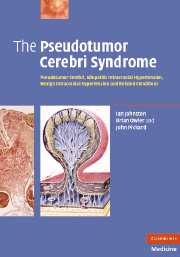 The Pseudotumor Cerebri Syndrome
The Pseudotumor Cerebri Syndrome Book contents
6 - Clinical features
Published online by Cambridge University Press: 21 August 2009
Summary
Introduction
The clinical features of PTCS are well-established and largely uncontroversial, unlike, for example, the issues pertaining to disease mechanism and treatment. Thus, there are now several epidemiological studies which provide sound information on the incidence of the syndrome in the general population as well as some indication of differences in geographically different populations. These studies also confirm the quite distinctive age and sex distribution patterns of PTCS which are apparent in clinical studies. Likewise, the symptoms and signs of PTCS are well-established. Thus, the four most common symptoms are headache, nausea and vomiting, disturbances of visual function, and diplopia, whilst the four most common signs are papilloedema, reduction of visual acuity, restriction of visual fields, and VIth nerve palsy.
There are, however, notable if infrequent variations in the ‘standard’ clinical presentation which clinicians need to be aware of. These involve the absence of one or more of the four main symptoms and absence of one or more of the four main signs. Less commonly, there is the presence of additional symptoms and/or signs. Also, there are to some extent variations in the nature of the clinical presentation in children and, to a lesser extent, in men which should be recognized. In this chapter, after reviewing the epidemiology, the nature, frequency, and duration of the clinical signs will be considered, followed by identification of some of the atypical presentations, and finally, a consideration of issues relating to differential diagnosis.
- Type
- Chapter
- Information
- The Pseudotumor Cerebri SyndromePseudotumor Cerebri, Idiopathic Intracranial Hypertension, Benign Intracranial Hypertension and Related Conditions, pp. 127 - 147Publisher: Cambridge University PressPrint publication year: 2007
- 1
- Cited by


